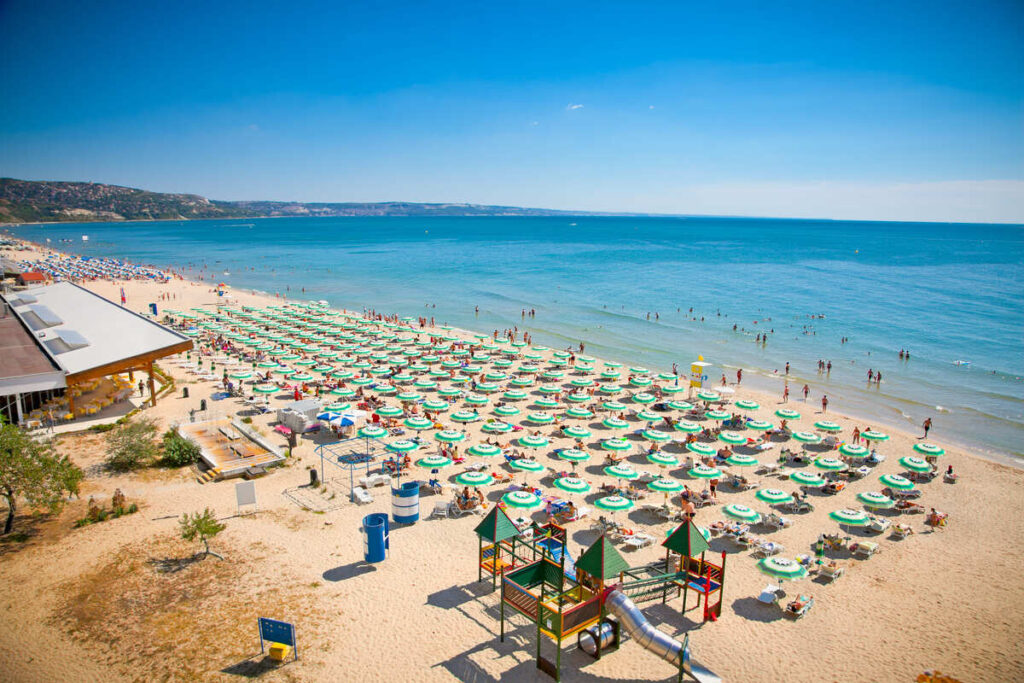No products in the cart.
Travel Guide
This Is One Of The Trendiest Beach Destinations In Europe For Summer 2023 – And It’s Not In The Mediterranean
Last Updated
We know summers in Europe are almost exclusively associated with scenic drives along France’s Côte d’Azur, Italy’s street corner gelaterias and art galleries, and leisurely afternoon strolls in Spain’s ocher-tinged small towns – as some might call it, the quintessential Mediterranean starter package. But what if we told you one of the trendiest beach destinations in the continent right now is, in fact, not located in the famous basin?

We haven’t even seen the first snow of the season yet, but our hearts and minds are already set on the hotter months to come. Now that pandemic-related restrictions have been dropped and normal tourism has resumed, demand for travel to Europe has skyrocketed, particularly over the summer holidays – and it is set to reach new historical heights next year.
Interestingly, there is a slow-burner of a coastal attraction emerging as a far more attractive alternative:
Meet Bulgaria’s Gorgeous Black Sea Coast

In case you weren’t aware, the Eastern European nation of Bulgaria does have a coast, and quite an extensive one at that, running for 378 km from its southernmost point, where it meets Turkey, to the North, bordering the fellow Balkan country of Romania – and contrary to popular belief, the Southern Mediterranean is not the only warm ocean in Europe.
The Black Sea can reach temperatures of up to 82.4°F (28°C) in summer, and despite its peculiar name, it couldn’t be a prettier shade of blue. It may not be crystal clear like the Adriatic branch of the Mediterranean or a bright azure like the French Riviera, but it is just as warm, if not warmer, and its calm waters are incredibly pleasant to swim in.
Top 5 Travel Insurance Plans For 2023 Starting At $10 Per Week

The Bulgarian Coast is also dotted with UNESCO-listed monuments and historical ruins, such as the insular Nessebar, referred to as the ‘Pearl of the Black Sea’. Nessebar dates back more than three millennia, and its collection of ancient landmarks, Romanesque churches, and well-preserved city walls, fully encircling the islet, are truly a sight to behold.
On top of that, white and golden sandy beaches comprise 130 km of the coastline, with the Varna and Burgas provinces, the latter of which includes Nessebar and its adjacent Sunny Beach, listed as the leading resort complexes in the country. On average, tourists can expect highs of 30 degrees from May through August in the Black Sea region.
A Hidden Treasure Recently Rediscovered

For decades, Bulgaria’s coastal gems remained concealed from foreigners due to the years the nation spent as a Communist regime and obscure satellite state for the Soviets. International tourism really began to flourish upon the country’s democratization and reopening to the outside world in the early nineties, in a move that ushered a rapid ‘Europeanization’.
Following the fall of the Berlin Wall and the collapse of the Soviet Union, Bulgaria began tilting westward, having succeeded in joining NATO and, more recently, in 2007, the European Union. While domestic visitors used to account for the largest share of tourism revenue in the past, now the balance has shifted dramatically.

In 2019, prior to Covid, 70% of Black Sea resort guests were foreigners, coming mostly from Germany and Eastern Europe, proving awareness of Bulgaria as a sunny hotspot is growing. In the first ten months of this year, passenger traffic in the airports of Varna and Burgas rose by 59% (jointly), as reported by Germany’s Fraport Group.
Individually, Varna is up by 43% annually, with 1.3 million tourists recorded between January and October; Burgas takes the lead, surging by 74% (1.63 million arrivals). It may not seem like much, but we must take into account the heavy competition Bulgaria faces on the Mediterranean front and the fact that it is not a first choice for a majority of travelers.
Is It Because It’s Cheap?

Of course, Bulgaria’s affordability as a destination may be partly to blame for its astronomical rise in recent years: on average, the cost of living is 44.32% lower than in the United States, making it a safe haven for budget travelers, especially digital nomads looking to save money as they country-hop across Europe, while still accessing luxuries they wouldn’t elsewhere.
Booking ahead of time, vacationers can find week-long stays in five-star, all-inclusive hotels for as little as BGN 2,866.00, or only USD 1,565.94 – some high-end Sicilian resorts will charge that per night. If you want to bag a real bargain and, on top of that, avoid the crazy summer crowd, you better hurry: Bulgaria’s Black Sea Coast will not remain ‘off-path’ for long.

Its surprising growth rates alone are enough proof that the Black Sea is becoming more popular each passing year. Surely it will not be different in 2023, now that Bulgaria has removed all entry requirements pertaining to Covid, allowing travelers to cross the border freely without presenting vaccine certificates or undergoing testing.
Bulgaria Is Geographically Diverse

Bulgaria isn’t a place people would normally associate with sandy beaches and warm weather, being part of the South Slavic world, located in the Far East of Europe, and home to alpine peaks and packed with ski stations. A surprising fact many do not know, however, is that it is culturally and geographically diverse – more so than any of its neighbors.
To the West, close to the borders with Serbia and North Macedonia, the landscape is dominated by mountain ranges and deep valleys, frequently blanketed by snow over winter. In Central-South Bulgaria, the weather stays pleasant year-round, resembling that of Tuscany; as for the coast, it normally enjoys cool to mild winters and scorching summers.

There are no direct U.S. flights to Bulgaria, but once they are in Europe for their extended summer vacation, Americans can easily travel to Varna or Burgas using any major European city as a transit hub. Nonstop routes are available from Frankfurt, Dublin, London, Amsterdam, Copenhagen, Stockholm, Brussels, and dozens of other airports during the peak season.
Traveler Alert: Don’t Forget Travel Insurance For Your Next Trip!
↓ Join Our Community ↓
The Travel Off Path Community FB group has all the latest reopening news, conversations, and Q&A’s happening daily!

SUBSCRIBE TO OUR LATEST POSTS
Enter your email address to subscribe to Travel Off Path’s latest breaking travel news, straight to your inbox
This article originally appeared on TravelOffPath.com
Source link

